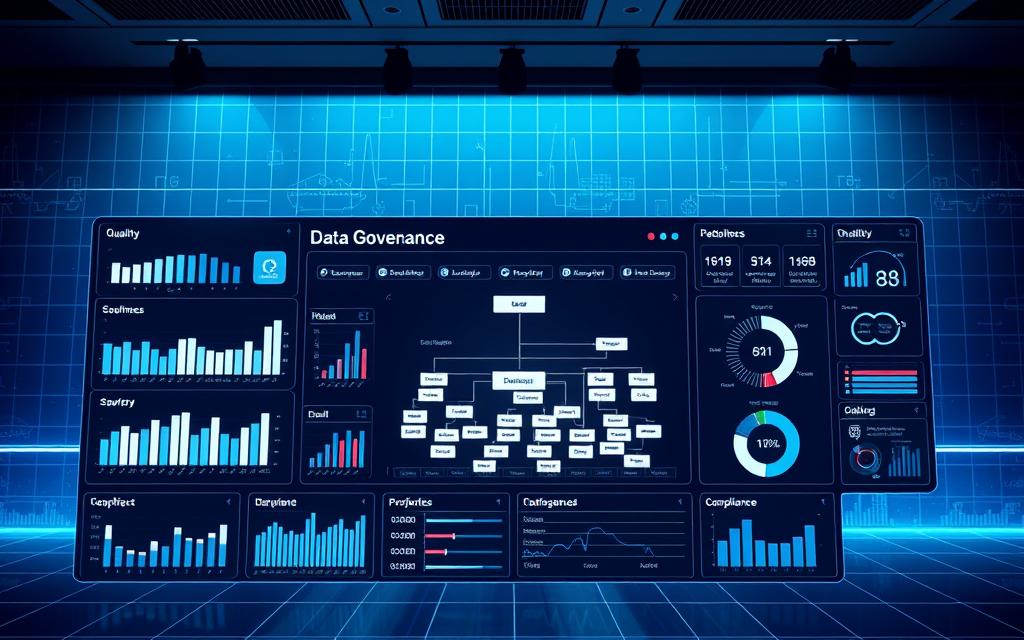Poor data quality costs organizations an average of $12.9 million a year. That number alone makes one question: how do you prove your governance program adds real value?
This introduction shows why simple, outcome-focused indicators matter. You need clear baselines and repeatable metrics to track quality, security, compliance, access, and usage over time.
What should you measure first? Start with accuracy, completeness, and timeliness — the core dimensions of data quality. Then add user-focused measures like time-to-access and a composite trust score that leaders can grasp quickly.
Throughout this guide you’ll see practical examples: percent of sensitive assets under control, audit trail completeness, mean time to revoke access, and a trust score that blends quality and user confidence. These indicators translate technical work into business value.
Ready to pick the right metrics and set a measurement cadence that guides improvement? Keep reading — the next section shows how to choose and baseline the indicators you actually need.
Why measure governance now: aligning intent, outcomes, and accountability
Start by asking: what will change if governance gets better, and who notices the difference? This simple question links intent to measurable outcomes.
Clarify who benefits and how you will prove it. Stewards may track certified asset adoption, compliance teams watch audit findings, and leaders expect faster decisions. Each view needs aligned metrics and clear ownership.
Measuring impact is tricky—results often appear as reduced risk or higher trust. That means you must blend numbers with narrative: quality scores plus stakeholder feedback paint a full picture.
Use a small, repeatable framework. Baseline quality, access request time, and dataset usage before change. Automate collection where possible and review indicators monthly or quarterly to keep accountability alive.
- Link intent to outcomes so indicators hold teams accountable.
- Blend quantitative measures with qualitative signals like training feedback.
- Keep the starter set small—clear indicators are easier to explain and adopt.
| Purpose | Example indicator | Owner |
|---|---|---|
| Quality & trust | Certified asset adoption rate | Data steward |
| Compliance | Open audit findings | Compliance lead |
| Access & usage | Time-to-access requests | Access manager |
Ask one guiding question when you choose indicators: will the business understand this, see improvement over time, and value the result? If yes, include it in your program.
KPIs for data governance success
Pick a compact set of indicators that translate technical work into business value. You want measures that executives, stewards, and compliance teams all understand at a glance.

Data quality and trust
Accuracy, completeness, consistency, timeliness, and uniqueness make trust measurable. Track percent of records meeting quality thresholds, monthly incident counts, and percent of tables with owners, descriptions, and lineage.
Compliance and security
Measure policy adherence, percent of sensitive assets tagged and access-restricted, number of policy exceptions, and mean time to revoke access after offboarding. Trends in incidents signal risk that needs attention.
Usage, operations, and training
Track certified asset consumption, catalog activity, time-to-approve requests, time-to-resolution for issues, onboarding speed, and duplication index. Also monitor percent trained, satisfaction, and assessment pass rates so governance sticks.
| Indicator | Example target | Owner |
|---|---|---|
| Quality score (composite) | 90% | Data steward |
| Access revoke time | <24 hours | Access manager |
| Certified asset usage | 30% increase | Product lead |
Keep the list small, assign an owner, and set clear targets. That way you turn metrics into repeatable improvement.
How to set up, baseline, and govern your KPI program
Aim for clarity—pick a few high-value measures that link to real business needs. Which three or four will show change fast?
Define and document each metric: name, calculation, data sources, owner, and target. That keeps reports consistent and auditable.
Record baselines for at least one month. Capture quality scores, incident counts, access approval times, and usage. Use these numbers to set realistic targets and small, measurable goals.
Automate collection and analysis
Use a data catalog to store ownership and tagging. Add lineage to map impact when a source changes. Layer observability tools to detect breaks and regressions in near real time.
Set cadence, owners, and escalation
Hold monthly reviews for performance and exceptions. Schedule quarterly trend deep dives. Assign an owner to each metric and define an escalation path when thresholds are breached.
- Start small with three to four metrics tied to business goals.
- Baseline for a month to understand the current number and trend.
- Automate using catalog, lineage, and observability to limit manual work.
- Document definitions, sources, and responsibilities to ensure clarity.
- Review monthly, dive quarterly, and escalate promptly when needed.
| Step | Action | Outcome |
|---|---|---|
| Define metrics | Document name, formula, sources, owner | Consistent, auditable reports |
| Baseline | Collect 4 weeks of measurements | Realistic targets and trend visibility |
| Automate | Catalog ownership, add lineage, enable observability | Faster alerts and reliable collection |
| Operate | Monthly reviews & escalation paths | Timely fixes and continuous improvement |
From metric to movement: measuring impact with disciplined change
Run small, controlled changes to see which actions actually move your key indicators. Start with a pilot—one team, one domain, one change—and keep everything else steady so you can attribute any shift to the intervention.
Isolate variables:
Isolate variables: pilot, phase, and A/B governance interventions
Use phased rollouts or A/B-style tests. Apply a new policy, tool, or stewardship workflow to one domain and leave another unchanged.
Compare baseline numbers to after-change results—incident rate, time-to-resolution, and access approval time. That reveals which change improved performance and which created friction.
Blend quantitative signals with stakeholder sentiment
Numbers tell one side of the story. Interview users and run short surveys to capture trust, clarity of ownership, and ease of discovery.
Keep a change log tied to metrics. Note dates, owners, and the exact intervention so when rates move you can trace the cause.
- Run pilots and phased rollouts to avoid confounding factors.
- Track before/after incident rates, resolution time, and access approval time.
- Retire experiments that don’t move the needle and double down on those that do.
| Measure | Baseline | Post-change |
|---|---|---|
| Incident rate | 12 per month | 6 per month |
| Time-to-resolution | 48 hours | 18 hours |
| Access approval time | 36 hours | 12 hours |
Translating governance metrics into ROI and business value
How do you turn governance measurements into clear dollars and hours on a balance sheet? Start by mapping each metric to cost, risk, or growth so leaders see immediate impact.
Cost and productivity gains are easiest to quantify. Fewer data issues cut rework and shorten time-to-insight—both translate to saved labor hours and faster delivery.
Risk and compliance
Measure reductions in violation counts, mean time to revoke access, and audit response effort. Those improvements lower exposure and shrink audit labor.
Agility and decision speed
Track shifts to certified sources and declines in validation cycles. More use of trusted assets means leaders act faster with confidence.
Adoption and collaboration
Standardized definitions, clear owners, and fewer duplicate reports reduce meeting cycles and reporting disputes. A catalog and lineage make traceability visible.
- Simple ROI bundle: incident number decrease, shorter resolution time, higher certified dataset usage, lower duplication index.
- Present before/after baselines and tie changes to specific interventions—this makes attribution credible.
- Partner with finance to validate savings and build executive-ready stories.
| Business driver | Indicator | Executive view |
|---|---|---|
| Cost | Rework hours saved | Dollars saved per quarter |
| Risk | Violation count | Reduced exposure and audit effort |
| Agility | Certified source usage | Faster decisions and fewer validation steps |
Best-practice playbook for governance KPIs across the organization
Design a clear playbook that links each metric to a decision and an owner. Who uses the number and why should guide what you measure.
Map metrics to stakeholder needs. Executives want decision speed and ROI. Stewards track certified dataset adoption. Compliance watches audit findings and sensitive exposure. Data teams monitor pipeline reliability and incident rates.
Prioritize indicators that prompt action—not vanity charts. Focus on pipeline success-to-failure ratio, tagging hygiene, lineage coverage, time-to-access, and classification coverage.

- Instrument end-to-end: pipeline health, tagging checks, observability traces.
- Drive adoption: catalog active users and contribution rate.
- Keep training measurable: coverage and pass rate.
- Set thresholds: spikes in incidents or drops in lineage trigger reviews.
| Indicator | Example target | Owner |
|---|---|---|
| Pipeline success ratio | 99% daily | Platform lead |
| Tagging hygiene | 95% classified | Data steward |
| Catalog adoption rate | 30% active users | Product owner |
| Mean time to access | <24 hours | Access manager |
Visualize with balanced scorecards, usage heatmaps, and concise audit summaries. That narration keeps investment and improvement moving across organization.
Move forward with confidence: focused metrics, automated tracking, continuous improvement
Make a compact plan that turns measurement into momentum. Pick a few meaningful metrics, record baselines now, and automate collection with catalog, lineage, and observability so manual work drops.
Set a steady cadence—monthly reviews and quarterly deep dives—so time compounds improvement. Roll changes out in phases and compare before/after results to isolate impact and reduce risk.
Use simple dashboards and scorecards that highlight access times, incidents, and adoption. Keep training active and measure pass rates to lock in gains.
Standardize definitions and owners across the organization and report outcomes in business terms—cost saved, risk reduced, and faster decisions.
Challenge: what one metric can you improve in the next 30 days to move your program forward?